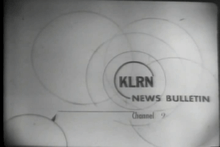KLRN
| San Antonio, Texas United States | |
|---|---|
| Branding | KLRN |
| Channels |
Digital: 9 (VHF) Virtual: 9 (PSIP) |
| Subchannels |
9.1 PBS 9.2 World 9.3 V-me 9.4 Create |
| Affiliations | PBS |
| Owner | Alamo Public Telecommunications Council |
| First air date | September 10, 1962 |
| Call letters' meaning | LeaRN |
| Former channel number(s) |
Analog: 9 (VHF, 1962–2009) Digital: 8 (VHF, –2009) |
| Former affiliations | NET (1962–1970) |
| Transmitter power | 13.6 kW |
| Height | 286 m |
| Facility ID | 749 |
| Transmitter coordinates | 29°19′38″N 98°21′17″W / 29.32722°N 98.35472°W |
| Licensing authority | FCC |
| Public license information: |
Profile CDBS |
| Website | www.klrn.org |
KLRN, virtual and VHF digital channel 9, is a PBS member television station located in San Antonio, Texas, United States. The station is owned by the Alamo Public Telecommunications Council (formerly the Southwest Texas Public Broadcasting Council). KLRN maintains studio facilities located on Broadway Street in downtown San Antonio, and its transmitter is located on Foster Road (near Calaveras Lake) in the southeastern part of the city.
The station also serves as the default PBS member station for the Laredo market and Victoria market, which does not have one of its own.
History
The station first signed on the air on September 10, 1962; it was founded by the Southwest Texas Public Broadcasting Council. Unusually for television stations of that time, it was licensed to serve two markets – San Antonio and the market to its adjacent northeast, Austin. This was due in part because Austin had been allocated UHF channel 18 for non-commercial use, and UHF was not considered viable at the time (television set manufacturers were not required to equip televisions with UHF tuners until the Federal Communications Commission passed the All-Channel Receiver Act in 1961, however UHF tuners would not included on all newer sets until 1964).
KLRN's transmitter was located roughly halfway between San Antonio and Austin on land located just north of New Braunfels, a major suburb of San Antonio. The station's main studios were located at the Jesse H. Jones Communications Center in Austin, on rented space at the University of Texas. Its San Antonio operations were based at a satellite studio located at Cambridge Elementary School until 1968, when it moved to rented space at the Institute of Texan Cultures on the HemisFair grounds.
Much of KLRN's schedule was carried by fellow PBS station KEDT in Corpus Christi, which had separate ownership from KLRN, during that station's first few years, following its sign-on in October 1972. Because of this arrangement, KLRN was also available to cable providers in the Lower Rio Grande Valley, some 250 miles from San Antonio.
In 1979, the Council signed on KLRU in Austin as a satellite of KLRN. From the very first day, however, the Council set about making KLRU a separate station focused on Austin. In 1980, KLRU received a separate governing board, though it continued to simulcast KLRN until 1984, when the Council activated a new tower for KLRN in San Antonio. In 1987, the two stations finally went their separate ways when the Southwest Texas Public Broadcasting Council split itself into two community organizations, with KLRN coming under the Alamo Public Telecommunications Council. In 1994, it moved to its current studio facility on Broadway Street, within a renovated former Buick dealership.
Digital television
Digital channels
The station's digital channel is multiplexed:
| Channel | Video | Aspect | PSIP Short Name | Programming[1] |
|---|---|---|---|---|
| 9.1 | 1080i | 16:9 | KLRN-HD | Main KLRN programming / PBS |
| 9.2 | 480i | 4:3 | KLRN-SD | World |
| 9.3 | KLRN-VM | V-me | ||
| 9.4 | KLRN-CR | Create |
Analog-to-digital conversion
KLRN discontinued regular programming on its analog signal, over VHF channel 9, on June 12, 2009, the official date in which full-power television stations in the United States transitioned from analog to digital broadcasts under federal mandate. The station's digital signal relocated from its pre-transition VHF channel 8 to channel 9.[2]
Notable programming
Some of the notable programs produced (in the Austin studio) by KLRN over the years included Carrascolendas and Villa Alegre, both children's programs about Hispanic culture that aired during the 1970s. KLRN also produced Austin City Limits until 1984, when KLRU split off into a separate station from KLRN and took over production responsibilities for that program.

KLRN, whose studios were right across the street from the Main Building of the University of Texas in Austin, interrupted programming to show live coverage of Charles Whitman's shooting spree on August 1, 1966.
References
- ↑ RabbitEars TV Query for KLRN
- ↑ "DTV Tentative Channel Designations for the First and Second Rounds" (PDF). Retrieved 2012-03-24.
External links
- KLRN official website
- Query the FCC's TV station database for KLRN
- BIAfn's Media Web Database -- Information on KLRN-TV